They were always behind the police lines and often out of sight behind trees or trucks, but because of the drills, you could always hear them working. The Kinder Morgan crews operating on Burnaby Mountain were, and remain, something of a mystery. Isolated by design or by happenstance, they were largely unreachable, since getting anywhere near a drill meant risking arrest by crossing into an injunction zone or getting into the less risky but also legally uncertain police exclusion zones that bordered the sites formally under injunction by the court. When not at work within the injunction zones, the Kinder Morgan workers were usually under police escort, or changing shifts after dark and early in the morning.
Indeed, after the initial heated encounter between citizens and survey crews on October 28th, contact with the Kinder Morgan workers on Burnaby Mountain was relatively limited, and very seldom face to face. The little enclaves of orange vests and machinery at the centre of the protests remained largely undisturbed, seemingly unconcerned by the heavy police presence surrounding them at all times and the ire of the protesters. In some cases, especially at the upper drill site known as borehole two, Kinder Morgan workers had a clear view of arrestees being processed by police. For the most part, they observed the arrests without comment or simply ignored them altogether. Who were these workers, and what did they think of the protests that were calling for them to stop work and leave the mountain? Finding out proved much more difficult than anticipated.
Activity at Borehole Two
Filmed on November 25th, this clip captures the work being done at the upper Kinder Morgan drill site on Burnaby Mountain known as borehole two. Almost as soon as I began to take photographs and film the workers, a Kinder Morgan employee — seemingly charged with site security — wandered over and started filming me right back with a go-pro chest camera.
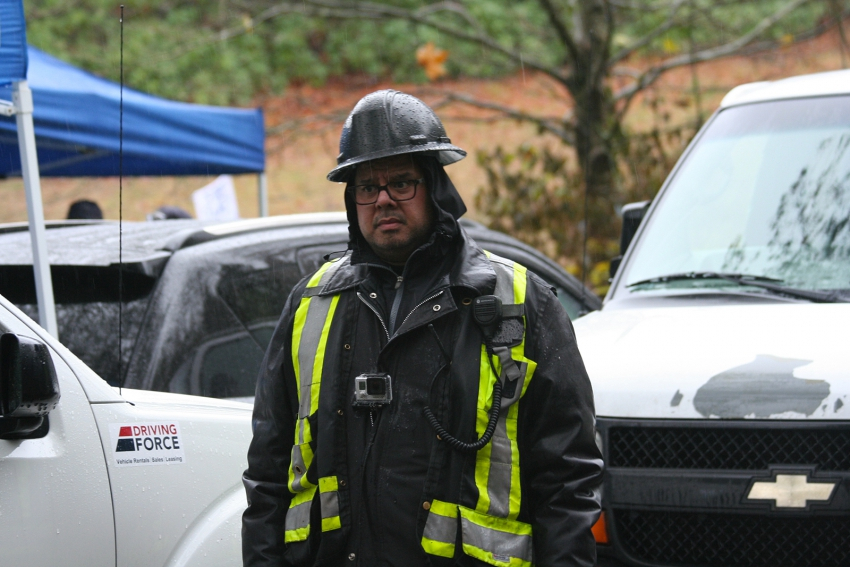
Activity at Borehole One
The lower drill site, known as borehole one, was located deep within the forested areas of the Burnaby Mountain conservation area. Though it was constantly alive with the movement of the Kinder Morgan workers, the forest around it always seemed still. The deep greens of the forest's cedars and old growth trees were shockingly beautiful in the evening light, especially when glistening with rain. Despite the site being hidden away in the trees, the sound of the drill invariably led those who sought it straight to where Kinder Morgan was working.
This site had a different feel from the one higher up where the majority of the protests took place over the last two weeks. The absence of a visible police presence enforcing the injunction boundary was conspicuous, and without any other protesters or observers there to watch over what Kinder Morgan was doing, the operation here had the eerie feel of a secret science experiment taking place in a deserted location. It was hard not to feel like an interloper, especially because it was much more difficult to get close to the drill and see what was going on. Nevertheless, it was clear that the drill was being driven hard. Work seemed to be going at a fast pace here.
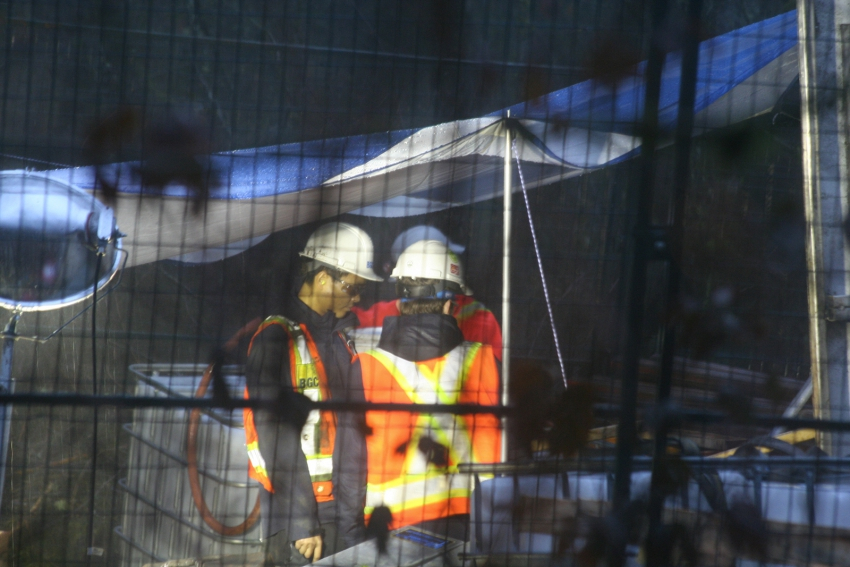
The double perimeter of police tape around the site, and fences enclosing the drilling compound itself, ensured that those hoping to get close enough to the Kinder Morgan workers to engage them could not do so without being spotted at a distance and risking arrest.
A chance encounter with a Kinder Morgan worker being escorted to this site by two RCMP officers later that day, however, did provide some insight into how workers were handling the situation on the hill. Crossing paths on the the trails that take you out of the forest and back onto the streets of Burnaby, the worker greeted me with a cordial "good evening" as he passed. Once I started taking photos, though, he immediately sped up, perhaps surprised by the flash or suddenly anxious to get to the safety of the drill site. He quickly disappeared further up the path, the police keeping pace with him. It seems safe to conclude that he was somewhat on edge as a result of the protests.
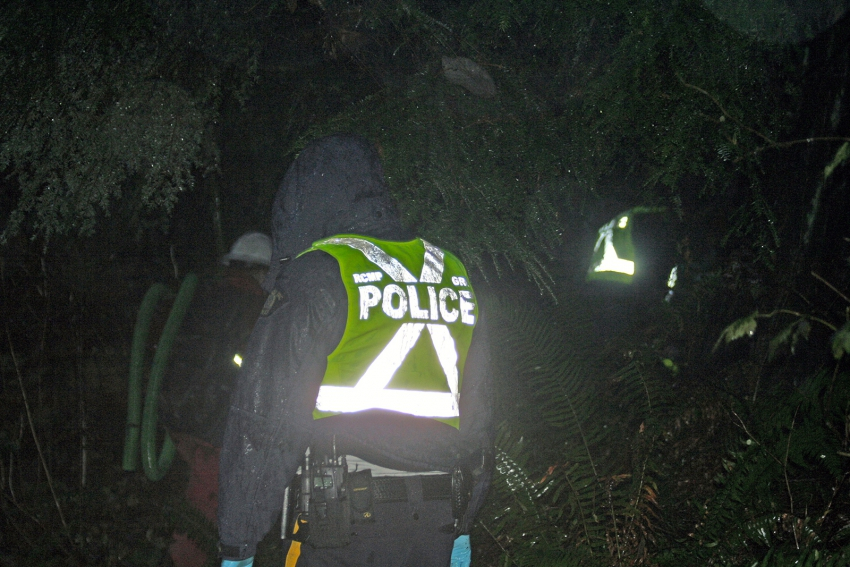
Finally, an interview
A Kinder Morgan "no comment" policy may very well have been in effect for workers on the hill. When it was possible to engage with them, they routinely refused comment or just left. Indeed, Trans Mountain does not seem to have had an official spokesperson on Burnaby Mountain at any time during the events of the last few weeks of protest, so almost all contact with the company has been through head office spokespeople or press releases. Such communication does little to provide a sense of the character and thoughts of the men (there may have been women out there as well, it is currently unknown) in the hardhats and rain slickers on the ground, however.
It was not until November 27th, the day that Grand Chief Stewart Phillip crossed police lines and was arrested, that a Kinder Morgan employee at work on Burnaby Mountain agreed to speak with me.
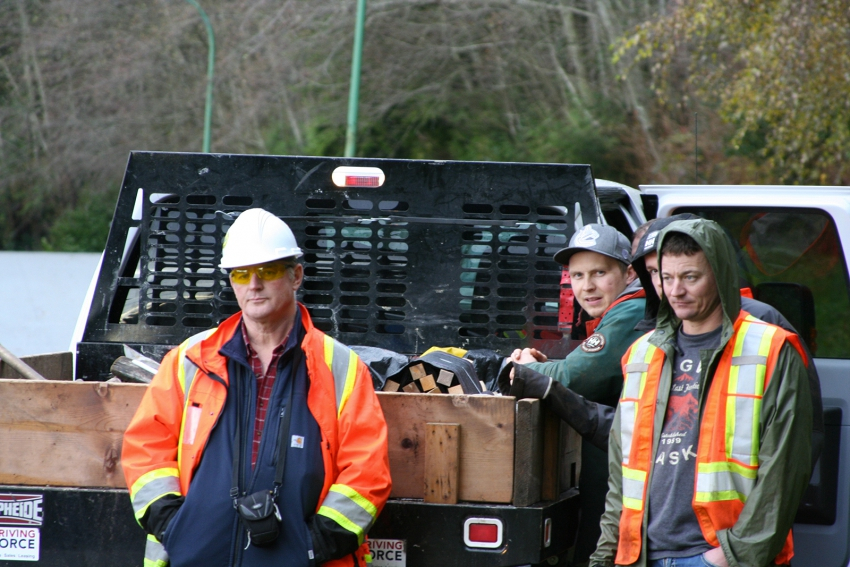
Giles Stevenson, Chief Environmental Inspector for Trans Mountain (left) and a Kinder Morgan restoration crew.
The Kinder Morgan crew was highly noticeable. They were wearing bright orange and were gathered around a work truck at a slight distance from the assembly of police vans, officers, media and those on Ridgeview Drive awaiting the emergence of the Grand Chief and the Tsleil-Waututh elder Amy George from the forest above where they had been arrested earlier in the day.
Upon approaching the Kinder Morgan workers for comment, their crew chief was open to dialogue. His name was Giles Stevenson and he was the Chief Environmental Inspector for Trans Mountain. When the president of Kinder Morgan, Ian Anderson, says that Trans Mountain will "leave the mountain as healthy as we found it," Giles Stevenson is the guy (or someone like him) that gets sent in to try and make that happen.
At different moments throughout the interview Stevenson specified that he spoke on behalf of himself and the particular work he was assigned to do on Burnaby Mountain, not on behalf of Kinder Morgan as a whole.
He began by describing how he and his crew were there to "tidy up" the work site in order to "be as environmentally sensitive as we can."
"We appreciate that some people are against this," he said, referring to the expansion of the Trans Mountain pipeline, "but we are just here to do our work and try and keep the site as tidy as we can."
When asked how the morale of the Kinder Morgan crews was faring, Stevenson responded quickly — "Oh, great." He admitted, however, that "it's a fairly pressured kind of atmosphere."
"But I think that we're just doing the work we're supposed to do and that we like doing. That's no more pressure than a lot of things we do."
Stevenson was then forthcoming about why he likes his work.
"I really enjoy putting the land back to either a natural condition or the function that it was meant to have. Say, for instance, you were in a wilderness or pristine area — we try and return the land back to that function, and the function for the things that live there. We sort of try to have a holistic view about what we do."
"Obviously, when we're in an urban situation, we have to consider the human element and what people want of their environment, whether it's a park or whether it's somebody's garden."
Given the scale of the protests that had been occurring over the last few days, it only seemed appropriate to ask what he thought of the opposition to Kinder Morgan's work in Burnaby, and whether — if indeed he was concerned with respecting the wishes of the people — it changed the way he viewed his work.
In regards to those who oppose Kinder Morgan's plans to run a pipeline through Burnaby Mountain, Stevenson began by saying "that's obviously their prerogative to have that opinion," then, after a pause, he noted that "it's a big consideration for what we're doing, obviously."
He continued: "I personally do not understand how people can drive motor cars and have the standard of living they have without having the oil products shipped to them. But I also appreciate people's concerns about climate change and how we might do things differently in the future."
I asked how he squared his appreciation of concerns over climate change and the integrity of the wilderness with his work for Kinder Morgan, which, as its website states, is the largest energy infrastructure company in North America. Here Stevenson seemed careful to distinguish his own work as an environmental specialist in charge of restoration from that of the rest of the company.
"I fully believe that in the work that I do that we are stewards of the landscape that we're in. We try to put it back — as I said before — the way we found it. We study it very, very carefully before we build or are allowed to build a pipeline. We submit all those studies to the NEB. We hope people read them and understand them — they're very complex. But we base our work on scientific evidence and on social evidence as well. For instance, I believe that the majority of people along the route are not opposed to the pipeline."
When asked to substantiate this last claim, Stevenson initially directed me towards the information that Kinder Morgan itself made available to the public, before acknowledging that one might consider this a biased source. He then referred to his positive personal experiences working on other sections of the Kinder Morgan pipeline expansion as evidence for his claim, noting especially his work on the section that runs through Jasper National Park. "I was involved with that," he said, "and we got an award for our sensitivity to the environment."
Stevenson is referring to the 2010 Emerald Award that Kinder Morgan received for — according to the Alberta foundation that grants the award — their work in "maintaining, and in some cases enhancing, ecological and commemorative integrity in Jasper National Park and Mount Robson Provincial Park," during and after the completion of the Anchor Loop project that is one part of the planned Trans Mountain pipeline expansion. Many of the main sponsors of the Alberta Emerald Foundation are large Canadian oil and gas companies operating in the Alberta tar sands, including ConocoPhillips, Enbridge and Syncrude. The Foundation's current board of directors displays similar connections to Canada's oil and gas giants.
A CBC report from 2008 covering the Kinder Morgan restoration project that eventually received the Emerald Award quotes Stevenson as saying there was "a community of restoration specialists and scientists who [were] very interested" in what he and his team were doing as a precedent for the industry. It is in regards to his experiences working on this project that Stevenson then suggested "we had very good relationships with both Jasper National Park and with Mount Robson Provincial Park when we were there."
Did Kinder Morgan experience any pushback when they were working in Jasper National Park and Mount Robson Provincial Park?
"There was certainly pushback, but it wasn't of the same nature as this, no," he said, referring to the protests on Burnaby Mountain.
"I think different issues have come to the surface since we started the construction in '07, but we were studying it well before that. Obviously the climate change issue has ... " — he paused, considering, then just said — "... is large."
When asked what issues with climate change stood out to him, he answered carefully: "For me personally, and this is nothing to do with — I'm certainly not speaking for Kinder Morgan — but I think that we as a society have to look at what we want in the future, how we're going to develop."
At this point the Grand Chief Stewart Phillip and Ta'ah Amy George emerged from the forest under escort by police, followed by a long line of arrestees and supporters, and the interview came to an end.
After the Grand Chief and Amy George were taken back up to the top of the mountain and the arrestees had finished filing down off the paths, Stevenson and his crew shouldered their tools and restoration supplies and hiked into the forest in the direction of borehole one.

An attempt at talking to another worker who walked out of the forest shortly thereafter and seated himself on the back of the Kinder Morgan work truck to light a cigarette did not prove as revealing a discussion as that with Stevenson. Presumably just off shift after working at the lower drill site, or at least on a break, he was dressed in blue coveralls and still wearing a white hardhat. When I inquired if he'd let me ask him a few questions his immediate response was a firm "nope." He took a drag on his cigarette then exhaled, a cheeky half smile on his face as he looked at me.
"Why don't you feel like talking?" I asked.
He shook his head. "I don't talk much anyways."
"So why would you talk to a reporter, right?" He smiled and nodded, and that was that.
By 10:30am the next morning Kinder Morgan was already flying the last of its drilling and survey equipment off of Burnaby Mountain by helicopter. Now they are off the hill completely. For how long, though, nobody knows.
In a December 1st press release, Trans Mountain confirmed that it had filed its Burnaby Mountain routing studies with the National Energy Board. Interveners now have until 10 February 2015 to review and respond to the findings that Kinder Morgan presented to the NEB on Monday.

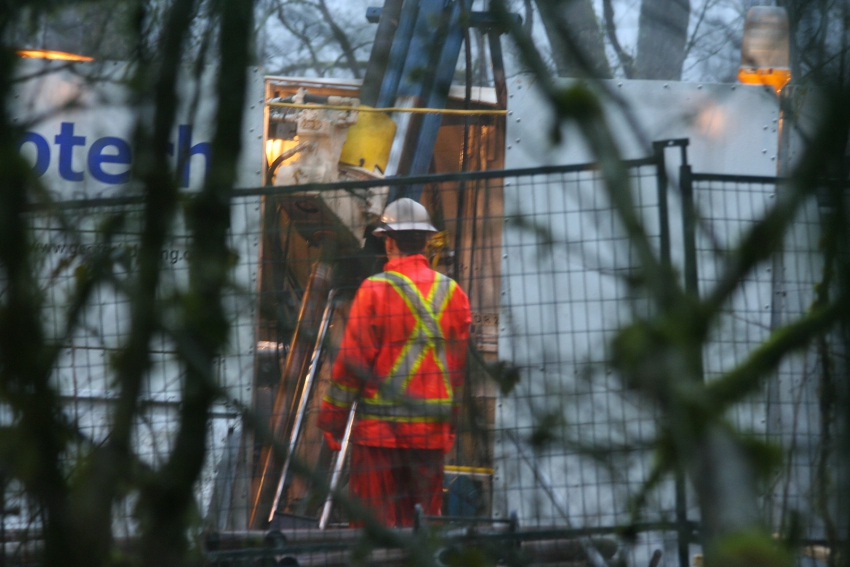
Comments